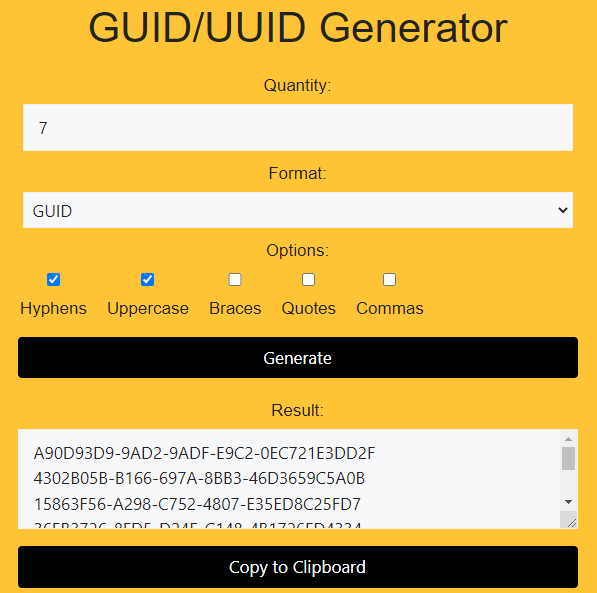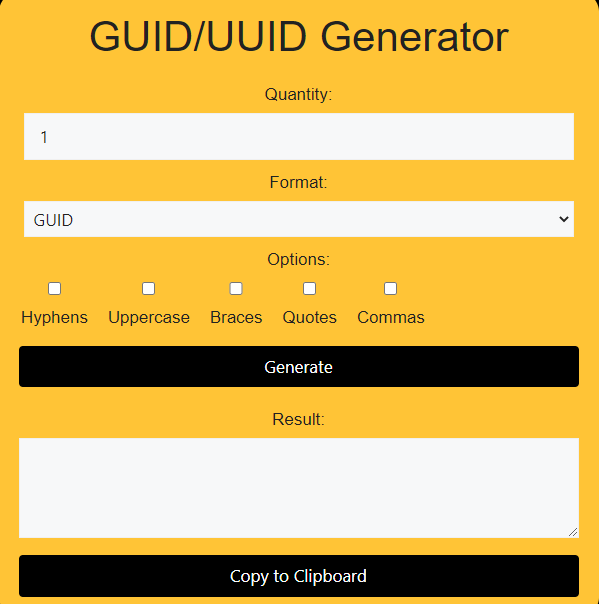UUID - GUID GENERATOR
VERSION 1
Version 1 UUIDs are generated based on the current timestamp and the machine's unique identifier (usually the MAC address).
VERSION 3
Version 3 UUIDs are generated based on a namespace identifier and a name (usually hashed using MD5).
VERSION 4
Version 4 UUIDs are generated using random or pseudo-random numbers.
VERSION 5
Version 5 is Similar to Version 3 but uses SHA-1 instead of MD5 for hashing.
What is a GUID Generator and UUID Generator ?
A universally unique identifier (UUID) is a 128-bit number used to uniquely identify information in computer systems. The term globally unique identifier (GUID) is also used, typically in software created by Microsoft. When generated according to the standard methods, UUIDs are, for practical purposes, unique. Their uniqueness does not depend on a central registration authority or coordination between the parties generating them, unlike most other numbering schemes.
The concept of a UUID generator is simple yet powerful. It’s a tool or function that creates a UUID, ensuring it’s unique across all space and time. This blog post aims to delve into the world of UUIDs and UUID generators, providing an informative and engaging read for the public.
Understanding UUIDs
UUIDs are a standardized form of identifiers used across software development, databases, and more. They are represented as 32 hexadecimal digits, displayed in five groups separated by hyphens, in the form 8-4-4-4-12 for a total of 36 characters (32 alphanumeric characters and four hyphens).
UUIDs are used in various applications, from tagging objects with an extremely short lifetime to reliably identifying very persistent objects across a network. They are used in network protocols, databases, software components, and more, wherever a unique identifier is necessary.
The Structure of UUIDs
A UUID is a 128-bit value. There are various ways to represent a UUID as a string, but the standard representation is in the form of 32 alphanumeric characters separated by hyphens. This string is broken down into five parts: a time-low, time-mid, time-high-and-version, clock-seq-and-reserved, clock-seq-low, and node. Each part represents a specific piece of the UUID and plays a crucial role in its uniqueness.
HOW TO USED GENERATED UUID ONLINE
- Distributed Systems: In distributed systems, multiple instances often need to create unique identifiers concurrently. UUIDs are perfect for this use case because they can be generated independently without needing coordination between instances.
- Databases: UUIDs are often used as primary keys in databases. They allow you to merge data from different databases without worrying about conflicts.
- File Systems: In file systems, UUIDs can be used to uniquely identify files or other resources, even across different systems.
- Session Management: In web development, UUIDs can be used to uniquely identify user sessions, providing a way to track user activity and maintain session state.
Generating UUIDs
UUIDs can be generated in several ways, depending on the specific requirements of the system. The most common methods include using online tools or programming languages. Each method has its advantages and disadvantages, and the choice between them often depends on factors such as the required speed of generation, the need for security, and the platform on which the UUID is being generated.
Best Practices When Using UUIDs
While UUIDs are incredibly useful, there are some best practices to keep in mind when using them:
- Avoid Premature Optimization: While UUIDs are larger than traditional integer IDs, don’t let this deter you from using them where they make sense. The benefits of global uniqueness often outweigh the costs of increased storage and memory usage.
- Use the Right Version: Different versions of UUIDs serve different purposes. Use the one that makes the most sense for your use case.
- Be Aware of Privacy Implications: Version 1 UUIDs include the MAC address of the machine where they were generated, which could potentially be used to track the machine. If this is a concern, consider using Version 4 UUIDs, which are randomly generated.
UUIDs in Databases
UUIDs are often used in databases as a unique identifier, especially in distributed databases where ensuring uniqueness can be complex. They offer several advantages over traditional incremental integer-based identifiers:
- Uniqueness across every table, every database, every server: UUIDs are unique across every table, every database, and every server, allowing easy merging of records from different databases.
- Better performance with distributed databases: Traditional integer-based keys can suffer from performance issues in distributed databases due to the need for coordination across servers to avoid key collisions. UUIDs, being globally unique, eliminate this need.
- No revealing information about your data: Incremental integer ids can reveal information about your records, such as the number of records in the database. UUIDs do not expose such information.
However, there are also some Disadvantages to using UUIDs:
- UUIDs are larger than integer IDs: This means they take up more space in your database and your cache. They will also take longer to compare.
- They are not easily memorable or readable: This can make debugging more difficult.
- The randomness of UUIDs can lead to fragmentation: This can impact the performance of your database.
Best Practices for Using UUIDs
While UUIDs are incredibly useful, they should be used judiciously. Here are some best practices for using UUIDs:
- Don’t use UUIDs for all keys: If a table will have a small number of records, or if rows will be frequently accessed by a key, consider using a traditional integer key.
- Use UUIDs for resources exposed to end users: This prevents users from guessing other resource’s ids.
- Store UUIDs in a binary format: This can help mitigate the storage size issue
UUIDs and Security
UUIDs play a crucial role in ensuring data security. They are often used as identifiers for sensitive data, such as user sessions or transaction records. Because UUIDs are unique and non-sequential, they are difficult to guess, making them a good choice for data that needs to be kept secure.
UUIDs also contribute to data anonymization. Because they do not contain any inherent meaning, they can be used to identify data without revealing any information about the data itself. This makes them a valuable tool in privacy-focused applications.
Future of UUIDs
As technology continues to evolve, so too will the applications and developments of UUIDs. With the increasing importance of distributed systems and the Internet of Things (IoT), the need for unique identifiers like UUIDs is only set to grow.
One area where we might see changes is in the generation of UUIDs. As computational power increases, it may become feasible to generate even more unique identifiers, potentially leading to new versions of UUIDs.
Screen Shorts


How Unique Generator UUID number is ?
A Generated UUID Number is a unique identifier that is computed by Windows and Windows applications. It is a 128-bit number that can be used to identify different resources, such as user accounts, documents, software, hardware, database entries, sessions, and more
The uniqueness of a GUID Generator and UUID Generator depends on the algorithm that is used to generate it. Different versions of GUID and UUID Generator use different methods, such as random numbers, timestamps, MAC addresses, or hashes
The probability of a GUID Generator being duplicated is very low, but not zero.
According to one source, if 1,000,000,000 GUIDs per second were generated for 1 year, the probability of a duplicate would be only 50%. Or if every human on Earth generated 600,000,000 GUIDs, there would only be a 50% probability of a duplicate Another source gives slightly different numbers, but the idea is the same: the chance of a collision is extremely small
WHERE TO USE GENERATED UUID / GUID NUMBER
A GUID and UUID generator is a tool that creates a unique identifier that is unlikely to be duplicated by anyone else. You can use them for various purposes, such as:
- Data Base: Creating a unique primary key for databases. This can help you avoid conflicts or errors when inserting or updating data in different tables or databases.
- Upload Files: Creating a unique filename for uploaded files. This can help you prevent overwriting or losing files with the same name on a server or a cloud storage.
- System Resources: Creating a unique name for system resources. This can help you identify and manage different components, objects, sessions, or processes in a software system or application.
- Unique ID: Creating and registering unique IDs without the need to contact a central authority. This can help you avoid the overhead or dependency of requesting an ID from a server or a service.
- Versions: A GUID generator can produce different versions of GUIDs that use different algorithms or formats. You can choose the one that suits your needs and preferences. For example, you can use a GUID generator that produces base 64 encoded GUIDs, URL encoded GUIDs, RFC 7515 compliant GUIDs, or GUIDs with hyphens, braces, quotes, or commas.
Feature of GUID Generator / UUID Generator
Uniqueness Assurance
GUID: GUID Generator is a globally unique identifier that is designed globally across space and time, making the likelihood of collision extremely low.
UUID: UUID identifiers are intended to be unique across different systems and networks.
Algorithmic Variants
GUID: Implementation of GUID on Microsoft’s slitly uses a combination of the current timestamp, machine-specific information, and a random element.
UUID: There are different versions of UUIDs (UUIDv1, UUIDv4, etc.) that utilize specific algorithms, such as timestamp-based or random-based, to generate unique identifiers.
Format and Structure
GUID: GUID Generator displayed as a 32-character hexadecimal number which is divided into five groups following a specific pattern.
UUID: UUIDs have a standard structure of 128-bit, which is represented as 32 hexadecimal characters separated by hyphens.
Randomness or Time-Based Options
GUID: GUID Generator depends on version, They can be generated using a combination of timestamps and random numbers.
UUID: UUID Generators are completely based on randomness, providing a straightforward way to generate unique identifiers.
Online Generator Tools
GUID: There are Online tools and libraries for generating GUIDs, which offer developers convenient ways to obtain unique identifiers.
UUID: UUID generators are online which provide a quick and accessible solution for developers to obtain UUIDs without the need for local installations.
UUIDs in Web Development
In web development, UUIDs are often used for session management and user tracking. When a user visits a website, a unique session ID is generated for them, often in the form of a UUID. This allows the website to track the user’s actions during their visit and provide a personalized experience.
UUIDs are also used in URL routing. By using a UUID as a unique identifier for each resource (such as a blog post or user profile), developers can create clean, RESTful URLs.
UUIDs in Distributed Systems
In distributed systems, UUIDs play a crucial role in ensuring consistency and reliability. Each node in a distributed system can independently generate a UUID without needing to communicate with other nodes, which is a significant advantage in environments where network latency is a concern.
UUIDs are often used as unique identifiers for records in distributed databases, ensuring that each record can be uniquely identified across multiple nodes. They are also used in message queues to uniquely identify messages, ensuring reliable delivery and processing.
UUIDs in IoT Devices
In the world of Internet of Things (IoT), UUIDs are used to uniquely identify devices. Each device in an IoT network can be assigned a UUID, allowing it to be uniquely identified and communicated with.
UUIDs in IoT devices are crucial for device management, data routing, and security. They allow for efficient communication between devices and servers, and they play a vital role in ensuring the integrity and security of IoT networks.
Conclusion
UUIDs and UUID generators are powerful tools that are widely used in software development, databases, and more. They provide a robust and efficient way to uniquely identify information in computer systems, making them an essential part of modern computing.
Whether you’re a developer looking to ensure uniqueness in your database records, a web developer managing user sessions, or an IoT engineer working on device identification, understanding UUIDs and how to generate them is a valuable skill.
Social Media links
FAQ
ask us
anything
What is the difference between GUID and UUID?
GUID (Globally Unique Identifier) is Microsoft’s implementation, while UUID (Universally Unique Identifier) is a more generic term used across different platforms and systems
How can I ensure the uniqueness of generated GUIDs or UUIDs?
Both GUIDs and UUIDs are designed to be globally or universally unique by incorporating factors such as timestamps, randomness, or MAC addresses.
Are GUIDs and UUIDs interchangeable in different programming languages?
Yes, UUIDs, being a more universal concept, can be seamlessly used across various programming languages and platforms.
Do online UUID generators guarantee unique identifiers?
Yes, reputable online UUID generators employ algorithms that ensure a very low probability of collision, ensuring uniqueness.
Which version of GUID or UUID is suitable for my application?
Depending on your requirements, choose between GUIDs with Microsoft-specific features or UUID versions like UUIDv4 for randomness and simplicity in cross-platform scenarios.
